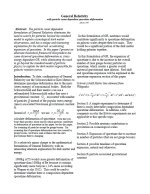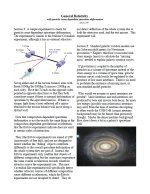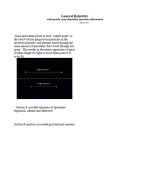Kharakov
Quantum Hot Dog
I'm expanding on the alternate General Relativity model that assumes spacetime deformation is not directly causally related to stress energy (mass equivalent in Newtonian gravitation) in a volume of spacetime, but is instead causally related to the number of non-gluon particles in a volume of spacetime.
There are a few differences between normal GR and alternate GR, and a few similarities:
They both predict the same spacetime geometry. Alternate GR doesn't postulate missing mass (dark matter), or dark energy.
Using Kepler's third law, you'd extract the number of particles in astronomical bodies instead of their mass, using a gravitational constant associated with the number of particles instead of mass.
Neutrinos, very low mass particles, contribute significantly to gravitational distortion of spacetime. In the alternate model GR, they are Dark Matter, and there is no valid reason to postulate the existence of particles beyond the Standard Model.
Some explanations (that might even be logically possible) of spacetime expansion and Dark Energy due to increase in total number of particles in spacetime... hidden one I'll leave up.. but mehh...:
1) Semi-static universe model: Total spacetime deformation does not increase over time, but is shared by all non-gluon particles within spacetime. As more non gluon particles are produced (mainly an increase in the # of neutrinos after baryon production dropped off), particles slowly lose individual gravitational strength. Red shift from further away galaxies and the CMB is explained because gravitational fields were stronger when there were less total non-gluon particles in the earlier universe, which means that light traveling away from stars (or CMB from the last scattering) was coming out of stronger gravitational wells. Initial BB conditions... mehh...
2) Total spacetime distortion increases over time as more non-gluon particles exist. This means that the total gravitational deformation of all of spacetime is increasing over time. Increased gravitation= increased gravitational time dilation. Emitted light's frequency is red shifted (post emission) as total gravitational time dilation increases. Hydrogen emission lines remain the same at initial emission, but over time light is red shifted as gravitational time dilation increases. In addition, it takes "longer" for light to travel the greater the gravitational time dilation is, which explains spacetime expansion. Initial BB conditions?
There are a few differences between normal GR and alternate GR, and a few similarities:
They both predict the same spacetime geometry. Alternate GR doesn't postulate missing mass (dark matter), or dark energy.
Using Kepler's third law, you'd extract the number of particles in astronomical bodies instead of their mass, using a gravitational constant associated with the number of particles instead of mass.
Neutrinos, very low mass particles, contribute significantly to gravitational distortion of spacetime. In the alternate model GR, they are Dark Matter, and there is no valid reason to postulate the existence of particles beyond the Standard Model.
Some explanations (that might even be logically possible) of spacetime expansion and Dark Energy due to increase in total number of particles in spacetime... hidden one I'll leave up.. but mehh...:
1) Semi-static universe model: Total spacetime deformation does not increase over time, but is shared by all non-gluon particles within spacetime. As more non gluon particles are produced (mainly an increase in the # of neutrinos after baryon production dropped off), particles slowly lose individual gravitational strength. Red shift from further away galaxies and the CMB is explained because gravitational fields were stronger when there were less total non-gluon particles in the earlier universe, which means that light traveling away from stars (or CMB from the last scattering) was coming out of stronger gravitational wells. Initial BB conditions... mehh...
2) Total spacetime distortion increases over time as more non-gluon particles exist. This means that the total gravitational deformation of all of spacetime is increasing over time. Increased gravitation= increased gravitational time dilation. Emitted light's frequency is red shifted (post emission) as total gravitational time dilation increases. Hydrogen emission lines remain the same at initial emission, but over time light is red shifted as gravitational time dilation increases. In addition, it takes "longer" for light to travel the greater the gravitational time dilation is, which explains spacetime expansion. Initial BB conditions?




